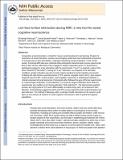| dc.contributor.author | Kleiner, Mario | |
| dc.contributor.author | Redcay, Elizabeth | |
| dc.contributor.author | Dodell-Feder, David | |
| dc.contributor.author | Pearrow, Mark J. | |
| dc.contributor.author | Mavros, Penelope L. | |
| dc.contributor.author | Saxe, Rebecca R. | |
| dc.contributor.author | Gabrieli, John D. E. | |
| dc.date.accessioned | 2012-04-05T17:49:36Z | |
| dc.date.available | 2012-04-05T17:49:36Z | |
| dc.date.issued | 2010-01 | |
| dc.date.submitted | 2010-01 | |
| dc.identifier.issn | 1053-8119 | |
| dc.identifier.issn | 1095-9572 | |
| dc.identifier.uri | http://hdl.handle.net/1721.1/69958 | |
| dc.description.abstract | Cooperative social interaction is critical for human social development and learning. Despite the importance of social interaction, previous neuroimaging studies lack two fundamental components of everyday face-to-face interactions: contingent responding and joint attention. In the current studies, functional MRI data were collected while participants interacted with a human experimenter face-to-face via live video feed as they engaged in simple cooperative games. In Experiment 1, participants engaged in a live interaction with the experimenter (“Live”) or watched a video of the same interaction (“Recorded”). During the “Live” interaction, as compared to the Recorded conditions, greater activation was seen in brain regions involved in social cognition and reward, including the right temporoparietal junction (rTPJ), anterior cingulate cortex (ACC), right superior temporal sulcus (rSTS), ventral striatum, and amygdala. Experiment 2 isolated joint attention, a critical component of social interaction. Participants either followed the gaze of the live experimenter to a shared target of attention (“Joint Attention”) or found the target of attention alone while the experimenter was visible but not sharing attention (“Solo Attention”). The right temporoparietal junction and right posterior STS were differentially recruited during Joint, as compared to Solo, attention. These findings suggest the rpSTS and rTPJ are key regions for both social interaction and joint attention. This method of allowing online, contingent social interactions in the scanner could open up new avenues of research in social cognitive neuroscience, both in typical and atypical populations. | en_US |
| dc.description.sponsorship | Simons Foundation | en_US |
| dc.description.sponsorship | National Institutes of Health (Postdoctoral National Research Service Award) | en_US |
| dc.language.iso | en_US | |
| dc.publisher | Elsevier | en_US |
| dc.relation.isversionof | http://dx.doi.org/10.1016/j.neuroimage.2010.01.052 | en_US |
| dc.rights | Creative Commons Attribution-Noncommercial-Share Alike 3.0 | en_US |
| dc.rights.uri | http://creativecommons.org/licenses/by-nc-sa/3.0/ | en_US |
| dc.source | PubMed Central | en_US |
| dc.title | Live face-to-face interaction during fMRI: A new tool for social cognitive neuroscience | en_US |
| dc.type | Article | en_US |
| dc.identifier.citation | Redcay, Elizabeth et al. “Live Face-to-face Interaction During fMRI: A New Tool for Social Cognitive Neuroscience.” NeuroImage 50.4 (2010): 1639–1647. Web. 5 Apr. 2012. | en_US |
| dc.contributor.department | Massachusetts Institute of Technology. Computer Science and Artificial Intelligence Laboratory | en_US |
| dc.contributor.department | Massachusetts Institute of Technology. Department of Brain and Cognitive Sciences | en_US |
| dc.contributor.approver | Gabrieli, John D. E. | |
| dc.contributor.mitauthor | Redcay, Elizabeth | |
| dc.contributor.mitauthor | Dodell-Feder, David | |
| dc.contributor.mitauthor | Pearrow, Mark J. | |
| dc.contributor.mitauthor | Mavros, Penelope L. | |
| dc.contributor.mitauthor | Saxe, Rebecca R. | |
| dc.contributor.mitauthor | Gabrieli, John D. E. | |
| dc.relation.journal | NeuroImage | en_US |
| dc.eprint.version | Author's final manuscript | en_US |
| dc.type.uri | http://purl.org/eprint/type/JournalArticle | en_US |
| eprint.status | http://purl.org/eprint/status/PeerReviewed | en_US |
| dspace.orderedauthors | Redcay, Elizabeth; Dodell-Feder, David; Pearrow, Mark J.; Mavros, Penelope L.; Kleiner, Mario; Gabrieli, John D.E.; Saxe, Rebecca | en |
| dc.identifier.orcid | https://orcid.org/0000-0003-2377-1791 | |
| dc.identifier.orcid | https://orcid.org/0000-0003-1158-5692 | |
| mit.license | OPEN_ACCESS_POLICY | en_US |
| mit.metadata.status | Complete | |
